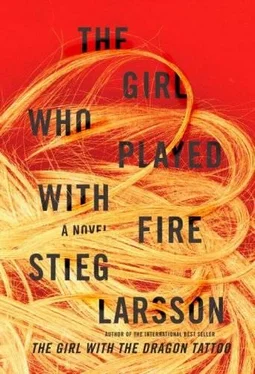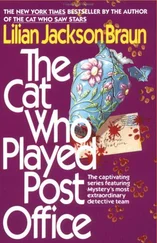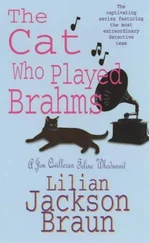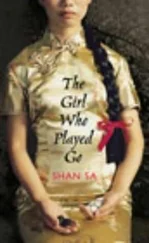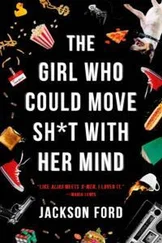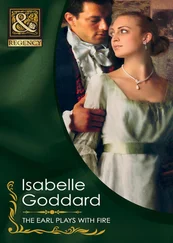Bublanski belonged to the Söder congregation and ate vegetarian food if kosher fare was unavailable. But he was not so Orthodox that he refused to work on the Sabbath. He immediately recognized that the killings in Enskede were not going to be a routine investigation. Ekström had taken him aside as soon as he appeared, just after 8:00.
“This seems to be a miserable story,” Ekström said. “The two who were shot were a journalist and his partner, a criminologist. And that’s not all. They were found by another journalist.”
Bublanski nodded. That effectively guaranteed that the case would be closely watched by the media.
“And to add a pinch more salt to the wound, the journalist who found the couple was Mikael Blomkvist of Millennium magazine.”
“Whoops,” Bublanski said.
“Well known from the circus surrounding the Wennerström affair.”
“What do we know about the motive?”
“So far, not a thing. Neither of the victims is known to us. They seem to have been a conscientious pair. The woman was going to get her doctorate in a few weeks. This case gets top priority.”
For Bublanski, murder always had top priority.
“We’re putting together a team. You’ll have to work fast, and I’ll ensure that you have all the resources you need. You’ve got Faste and Andersson. You’ll have Holmberg. He’s on the Rinkeby murder case, but it seems that the perp has skipped the country. You can also draw on the National Criminal Police as required.”
“I want Sonja Modig.”
“Isn’t she a little young?”
Bublanski raised his eyebrows in surprise.
“She’s thirty-nine, just about your age, and besides, she’s exceedingly sharp.”
“OK, you decide who you want on the team, but do it quickly. The brass are already after us.”
Bublanski took that to be an exaggeration. At this hour, the brass would be at breakfast.
The investigation formally began with a meeting just before 9:00, when Inspector Bublanski assembled his troops in a conference room at county police headquarters. He studied the group, not altogether happy with its composition.
Modig was the one he had the most confidence in. She had twelve years’ experience, four of them in the violent crimes division, where she had been involved in several of the investigations led by Bublanski. She was exacting and methodical, but Bublanski had observed in her the trait he regarded as the most valuable in tricky investigations: she had imagination and the ability to make associations. In at least two complex cases, Modig had discovered peculiar and improbable connections that all the others had missed, and these had led to breakthroughs. She also had a fresh, intellectual humour that Bublanski appreciated.
He was pleased to have Jerker Holmberg on his team. Holmberg was fifty-five and originally from Ångermanland. He was a stocky, plain individual, who had none of Modig’s imagination, but he was, in Bublanski’s view, perhaps the best crime scene investigator in the entire Swedish police force. They had worked on numerous investigations together over the years, and Bublanski was convinced that if there was something worth finding at a crime scene, Holmberg would find it. His immediate task would be to take command of the work in the apartment in Enskede.
Bublanski hardly knew Curt Andersson. He was a laconic and solidly built officer with such a short stubble of blond hair that at a distance he looked completely bald. Andersson was thirty-eight and had only recently come to the division from Huddinge, where he had spent years dealing with gang crime. He had a reputation for being hot-tempered and tough, which was perhaps a euphemism for the fact that he employed methods that were not quite by the book. Ten years back he had been accused of brutality, but an enquiry cleared him on all counts.
In October 1999 he had driven with a colleague to Alby to pick up a hooligan for interrogation. This man was well known to the police, and for some years had terrorized the neighbours in his apartment building. Now, as the result of a tip, he was to be taken in for questioning in connection with the robbery of a video store in Norsborg. When confronted by Andersson and his colleague, the hooligan pulled a knife instead of coming along quietly. The other officer collected several wounds to his hands, and then his left thumb was sliced off before the thug directed his attention to Andersson, who for the first time in his career was obliged to use his service weapon. He fired three shots. The first was a warning shot, the second was deliberately aimed but missed the man – no easy matter since the distance was less than ten feet – and the third shot hit him in the middle of his chest, severing the aorta. The man bled to death in a matter of minutes. The inevitable enquiry had ultimately cleared Andersson of any wrongdoing, but only solidified his reputation.
Bublanski had had doubts about Andersson at first, but after six months he had encountered nothing to provoke his criticism or wrath. On the contrary, Bublanski was beginning to have some respect for Andersson’s taciturn skill.
The last member of the team, Hans Faste, was forty-seven, a veteran of fifteen years in violent crimes, and the chief reason for Bublanski’s not being totally satisfied. Faste had a plus side and also a minus side. On the plus side, he had extensive experience – and of complicated investigations too. On the minus side, he was egocentric and had a loudmouth sense of humour that especially bothered Bublanski. But when he was kept on a short leash he was a competent detective. Besides, he had become something of a mentor for Andersson, who did not seem to object to his personality.
Inspector Nyberg of the criminal division had been invited to the meeting to report on her interview with the journalist Blomkvist during the night. Superintendent Mårtensson was also present to report on what had happened at the crime scene. Both of them were worn out and eager to go home to bed, but Nyberg had already managed to get photographs of the apartment, and these she passed around to the team.
After half an hour they had the sequence of events clear. Bublanski said: “Bearing in mind that the forensic examination of the crime scene is still in progress, this is what we think happened… An unknown person entered the apartment in Enskede without the neighbours or any other witness noticing and killed the couple, Dag Svensson and Mia Johansson.”
“We don’t know yet,” Nyberg said, “whether the gun that was found is the murder weapon, but it’s at the National Forensics Laboratory, and it’s top priority there. We’ve found a fragment of a bullet – the one that went into Svensson – relatively intact in the bedroom wall. But the bullet that struck Johansson is so fragmented that I doubt it will help much.”
“Thanks for that information. A Colt Magnum is a damned cowboy pistol that ought to be banned outright. Have we got a serial number?”
“Not yet,” Mårtensson said. “I sent the gun and bullet fragments to NFL by messenger direct from the crime scene. Better for them to take care of it than for me to start handling the weapon.”
“That’s good. I haven’t had time to go to the crime scene yet, but the two of you have been there. What are your thoughts?”
Nyberg deferred to her older colleague to speak for them both.
“First of all, we think it was a lone gunman. Second, it was an execution, pure and simple. I get a feeling that someone had very good reason to kill Svensson and Johansson, and he did his job with precision.”
“What do you base that on?” Faste said.
“The apartment was neat and tidy. It bore none of the hallmarks of a robbery or assault or anything like that. And only two shots were fired. Both hit their intended targets in the head. So it’s someone who knows how to handle a gun.”
Читать дальше
